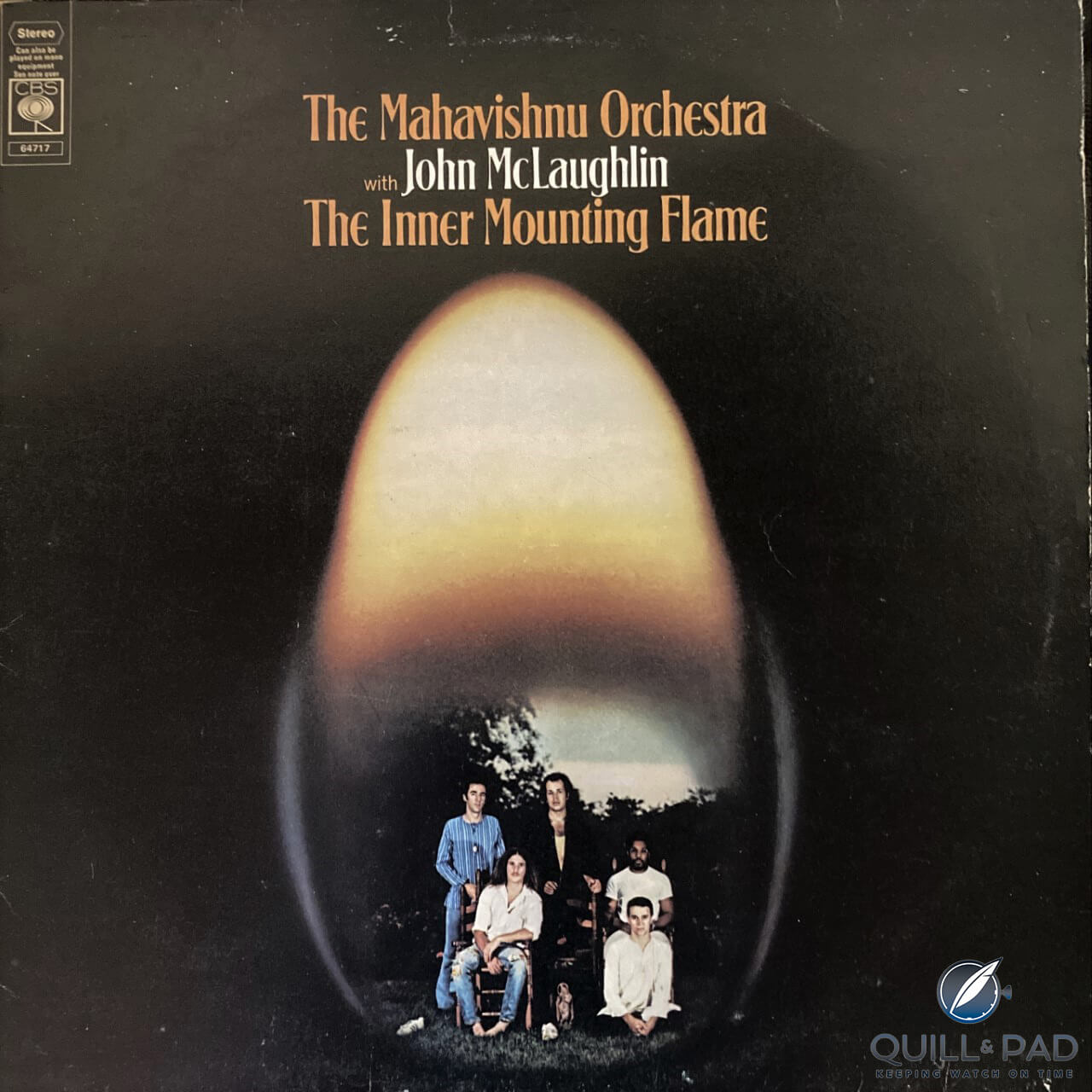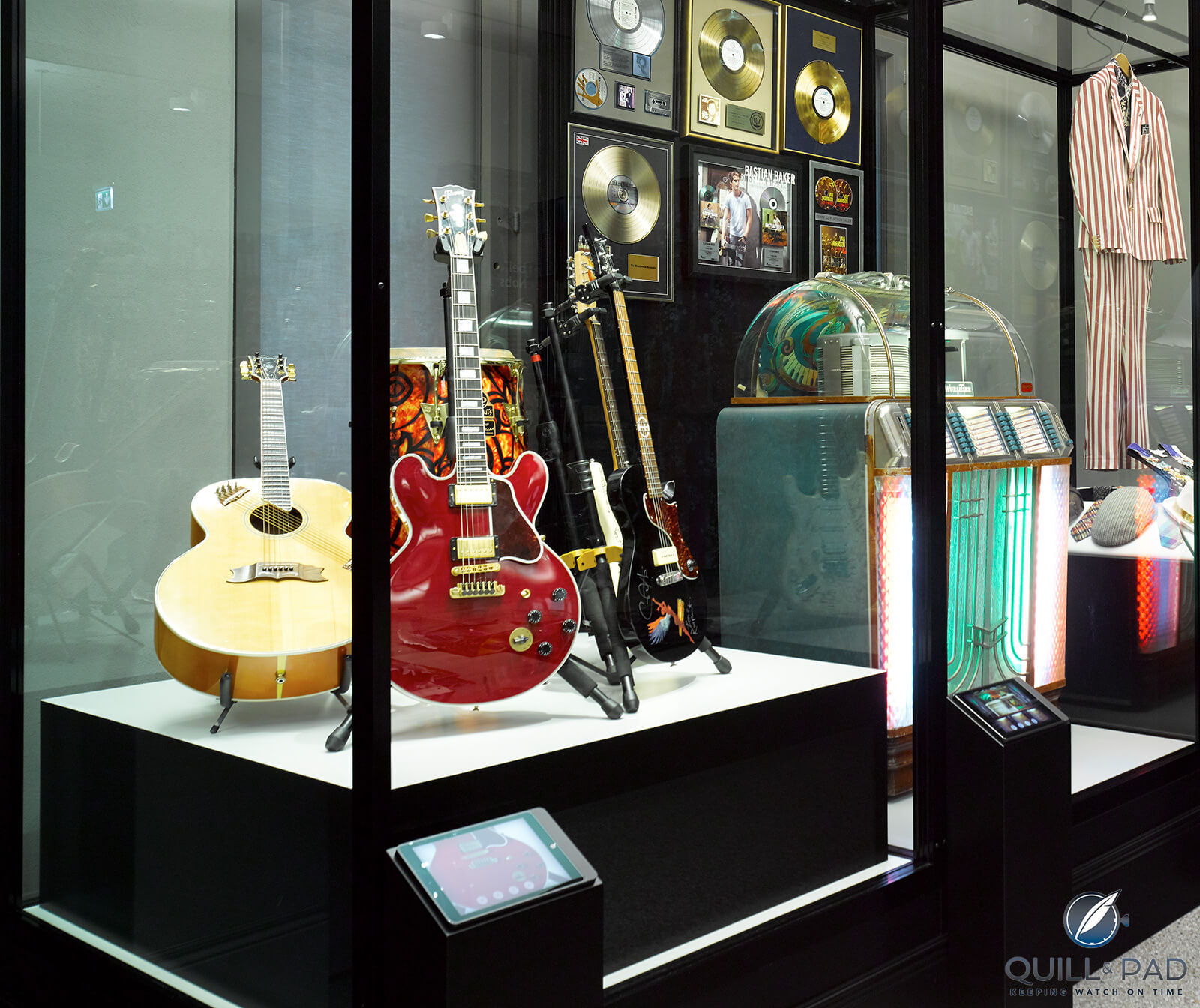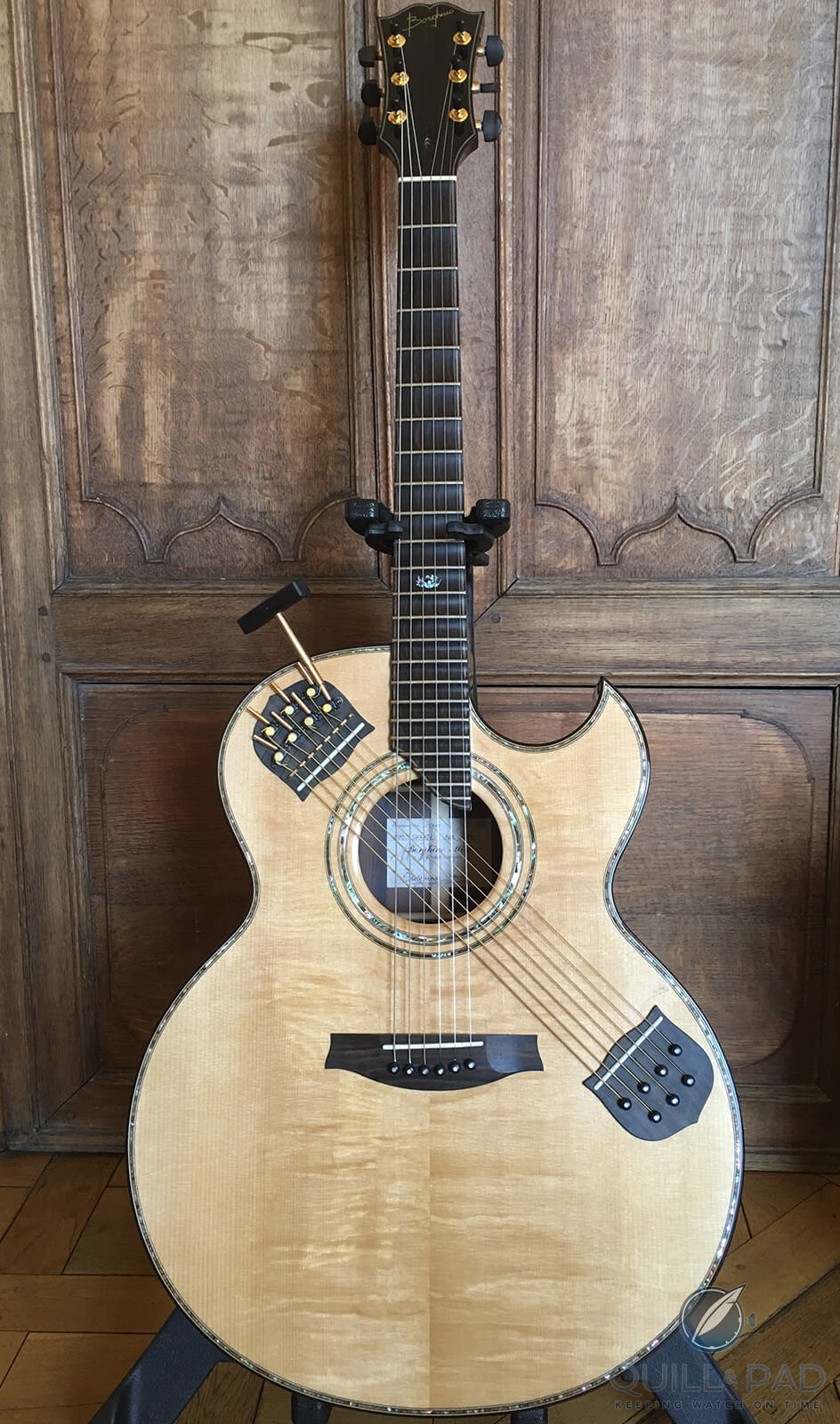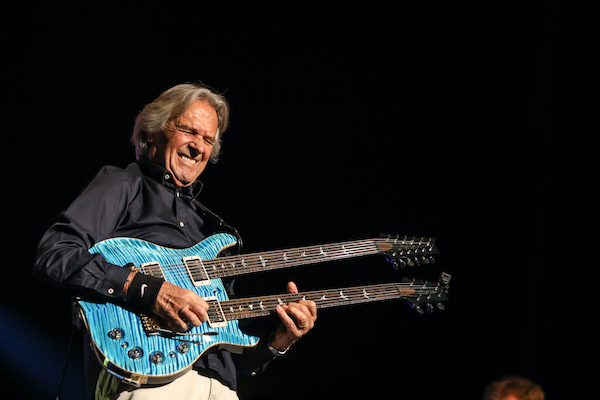When I was around 12 years old, my brother and I went to a concert featuring two jazz giants, pianist Oscar Peterson and guitarist Joe Pass.
The concert program mentioned that Pass was a regular winner of a DownBeat magazine reader’s poll, most often sharing the “top jazz guitarist” spot with Mahavishnu Orchestra’s John McLaughlin.

John McLaughlin with his 1950s LeCoultre and the “redhead” Gibson Johnny Smith (photo courtesy Ina McLaughlin)
Intrigued by McLaughlin’s apparently Indo-Celtic name, the next time I was in a record store I checked out his albums and asked the shop owner to let me hear the first Mahavishnu Orchestra album, The Inner Mounting Flame.
The album cover in itself was striking: four band members are standing or seated on chairs, but McLaughlin is seated on the grass in the lotus position with a Hindu deity by his side. The fact that Jerry Goodman has taken his trainers off looks like some secret code intended solely for the illuminati.

Mahavishnu Orchestra’s first album, ‘The Inner Mounting Flame’ (photo courtesy Colin Alexander Smith)
This was in the days when a record store had a row of turntables behind the counter and a row of headphones hanging on the wall so that you could listen before buying. To this day I can recall the boxy, compressed sound of those budget headphones, but they failed to diminish what was quite simply the most astonishing music I had ever heard, the sostenuto opening chords of “Meeting of the Spirits” clashing and resolving like waves upon the shore, but with an intensity verging on violence.
This was music that I had always suspected – or hoped – must be out there somewhere but had not manifested itself to me until this point. Even before the first track ended, I had marched across to the counter, handed over my £5, and took the record home.
Between 1969 and 1971, John McLaughlin had been recording in New York with Tony Williams and Miles Davis, but The Inner Mounting Flame launched the Mahavishnu Orchestra on the world, achieving rapid commercial success in the United States and Europe and introducing a broad swathe of rock fans to music that the press liked to describe as “jazz/rock” or “fusion,” but which, with its exotic and complex chords and 7/8 and 12/4 time signatures, had little to do with either jazz or rock such as they existed at that time.
McLaughlin created his own musical universe, with one concertgoer notoriously reporting leaving the concert hall feeling that he had been “rearranged on the molecular level.”
I subsequently followed McLaughlin’s career closely over the years, through his acoustic ventures with Indian musicians in Shakti, a hugely popular guitar trio with Paco de Lucia and Al Di Meola, and the numerous ensembles that he has led since then always featuring musicians of a caliber that McLaughlin was now able to attract – right up to his current group, John McLaughlin and the 4th Dimension, an ensemble that has been together since 2007.

John McLaughlin rocking the Audemars Piguet Royal Oak on stage in 1998 (photo courtesy David Redfern/Getty Images)
After I recently noticed McLaughlin wearing an Audemars Piguet Royal Oak in live footage from the 1990s along with various other interesting timepieces, I somewhat cheekily asked him for an interview to discuss his watches rather than his music or his guitars, to which he kindly agreed. Not surprisingly we ended up discussing all three.
Interviewing John McLaughlin
McLaughlin is an affable interviewee whose natural curiosity is evident and who enjoys swapping stories in an easygoing patrician manner and mid-Atlantic, mid-Mediterranean accent. If you didn’t know he was a 1960s London contemporary of Eric Clapton, Jimmy Page, Jeff Beck, and Keith Richards, you could be forgiven for thinking he might be a former British ambassador to Buenos Aires or Cairo (he slips with ease between languages and dialects depending on who he is talking to, and I recently heard him conduct a podcast interview with American drummer Vinnie Colaiuta entirely in a Bronx accent so fluent Robert de Niro would have been proud).
“A lot of watches – and a lot of guitars – have passed through my hands over the years!” he enthused.
We started with the customary wrist check, McLaughlin showing me his black-dial Audemars Piguet Royal Oak over Zoom, which he appreciates both for daily wear and for playing concerts because of its steel bracelet and very slim case, telling me, “It’s the skinny one, Colin!”

John McLaughlin relaxing poolside with his Audemars Piguet Royal Oak (photo courtesy Ina McLaughlin)
“My first watch . . . ? It must be the one given to me by my dad after I hadn’t seen him for many years as my parents split up when I was quite young. Must have been my twentieth birthday. It ran for a few years and then stopped, but I didn’t have the money to get it fixed so I went watchless for many years, which didn’t bother me. It was probably only when I moved to the U.S. and started earning decent money that I indulged myself!”
McLaughlin spent most of the 1960s in London, working variously as a session musician, van driver, and record shop salesman to make ends meet while playing in various rhythm and blues outfits in the clubs.
But a tape recording of his playing found its way to Miles Davis’ former drummer Tony Williams and then to Davis himself, with McLaughlin very soon thereafter finding himself in New York, playing on the seminal recording sessions of In a Silent Way, Bitches Brew, and Tribute to Jack Johnson, through which Davis singlehandedly altered the direction of jazz and contemporary music as a whole.
I asked McLaughlin whether he remembers the first nice watch he bought himself.
“Around that time, I bought two vintage Elgin watches from 1928 from a jeweler in New York for $1,500, one in white gold and one in yellow gold. I went back a year later and he said, ‘Hey John, do you still have those Elgin watches? I’ll give you double what you paid for them . . .’ But I kept them, and in fact my wife now has the yellow gold one, and I gave the white gold one to my son for his twenty-first birthday.”
For the purposes of the interview, I had sent McLaughlin some photos from various websites dating back to 1971, and we had set about trying to identify the watch and the year, sometimes with clues from the guitar he was playing at the time.

John McLaughlin with a gold Rolex GMT and a Gibson ES-345 (photo courtesy John Sievert/Getty Images)
“After the Elgins I bought a Rolex in a fit of madness, a gold one,” McLaughlin said, which has been identified by fellow Quill-and-Padder Nick Gould as a GMT on a President bracelet. “But I didn’t like it, it was too ostentatious, so I got rid of it. I can’t really wear gold jewelry. The guitar in that photo is a Gibson ES-345 with a scalloped fingerboard, a beautiful guitar, which I still have.”
McLaughlin has often used custom-made guitars on which the space between each fret has been scalloped out to facilitate deeper bending of notes, inspired by the Indian sitar.
“I also had a Rolex Submariner at one point but that was too big and heavy. My eldest son got that one. I understand it must be worth something now!”
Is John McLaughlin a collector?
I asked McLaughlin whether he considered himself a collector of either guitars or watches.
“No, and in fact I don’t like guitar collectors. I like watch collectors, but musical instruments are like people: they need to be looked after and they need to be played or they get ‘wobbly,’ they go permanently out of tune. When people buy fine musical instruments and lock them away in the hope that they will go up in value, they actually deteriorate. They should be in the hands of a musician, especially as many musicians struggle to own a decent instrument.
“I have about ten guitars, including two very old and tiny classical guitars that are unplayable, but I must have given away many more. Guitar companies often give me guitars, but if I’m not playing them, I pass them on to someone who will.”
In the guitar world, there is one particular “grail” model that attracts the same degree of fevered longing as a Rolex “single red” Sea Dweller or Paul Newman Daytona: the 1959 Gibson Les Paul Sunburst, of which some 1,800 were made. These were used by the likes of Jimmy Page, Eric Clapton, Peter Green (of the original Fleetwood Mac), and Duane Allman and are appreciated for their iconic, piercing sound (listen to Fleetwood Mac’s “Albatross” or Led Zeppelin’s “Stairway to Heaven” for examples).
At one point in the early 1980s McLaughlin owned a 1958 Gibson Les Paul Sunburst, which he recognized among the photos I had sent him after I had tracked it down on a Les Paul guitar forum.

1958 Gibson Les Paul Sunburst owned by John McLaughlin in the 1980s (photo courtesy lespaulforum.com)
McLaughlin must have been looking for a warmer sound because he soon traded the Les Paul for three Gibson “Johnny Smith” model jazz guitars through a dealer in Paris. Two of these he still owns (“the blonde and the redhead”), the third (“the brunette”) having been given to a South African guitarist he had known in his London club days who he knew was in need of a decent instrument.
“Some time after that I also got given a beautiful Breitling as a birthday present on a blue leather strap,” McLaughlin recalled.
“I wore it for a few years and then gave it to my drummer at the time, Dennis Chambers, who really loved it. But Dennis hits the drums hard, and once when he was playing a gig at the Tokyo Blue Note in the 1990s he decided that wearing it while playing the drums probably wasn’t going to do the movement any good, so he took it off and hung it on the cymbal stand. But he forgot to put it back on when the band went backstage for a break, and by the time he remembered it and went back to get it was gone. So that was the end of that one.”
Still in the 1990s, John also received one of his favorite watches as a gift from his wife – a 1950s gold LeCoultre, which remains one of his favorites to this day. “But I don’t wear it very much for concerts because it’s on a leather strap and my wrist gets sweaty, which eventually destroys the strap.”
“Another favorite, which I got around 1985, is my Cartier Tank Reverso [Basculante], probably a 1970s model,” McLaughlin continued, “because it’s slim and light, but it suffers from the same problem. That one stopped working a few years ago so I took it to Cartier for repair.”
Here, the guitarist leaned in conspiratorially as if to share a confidence. “You know, I don’t think they repair it, I think they just replace the whole mechanism, it’s modular and they just replace it. Anyway, it’s been running like new ever since!”

John McLaughlin relaxing at home with his Cartier Tank Basculante (photograph by Ina McLaughlin)
“About five or six years ago I was asked by drummer Cindy Blackman to play on a couple of tracks on her album, Give the Drummer Some. Cindy is an old friend from way back, she’s married to Carlos Santana. When she asked me what my fee would be I said don’t be silly, you’re a friend, I’ll do it for you! Anyway, next time she and Carlos were in Monaco, they came round and as a thank you for doing the album she gave me this Hublot, the new one. Now that one I like for playing: it’s quite heavy but it’s on a rubber strap, which is impervious to sweat.”

John McLaughlin performing in Berlin wearing his Cartier (photos courtesy Frank Hoensch/Getty Images)
I asked McLaughlin about one of the photos I had sent him, a black-and-white shot of him sitting with the musicians with whom he recorded his 1974 Apocalypse album wearing a typical 1960s watch on a Bund strap and holding an extraordinary double-neck guitar with tree-of-life inlays running the full length of the fingerboards made especially for him by a luthier called Rex Bogue.

John McLaughlin (center) with the Rex Bogue double-neck guitar, watch unknown; violinist Jean-Luc Ponty is standing behind McLaughlin (photo courtesy audiofanzine.com)
“I’m afraid I have no idea what that watch is, but I can tell you what happened to that guitar unfortunately,” he answered. “We were in the band room after a show and the guitar was laid flat on a table. There must have been some kind of tremor – not an earthquake, exactly, but a tremor – because the guitar just fell off the table and fell flat on its face on the floor. The bridges were pushed into the body, which had a big split; it was beyond repair. It was insured but it was a unique piece, irreplaceable.
“Now I was on tour with Jeff Beck at the time, must have been around 1975, he was playing Gibson Les Pauls and he lent me a Les Paul to finish the tour. So when we finished the tour I went out and bought him a 1968 white Fender Stratocaster; it wasn’t that expensive at the time, but as everyone knows he’s been playing white Strats ever since – isn’t that sweet?”
John McLaughlin and Switzerland
McLaughlin has been a regular performer at the Montreux Jazz Festival over the years. The lineup of sponsors usually includes a Swiss watch manufacturer (most recently it has been Audemars Piguet). One year it was Ebel, who presented him with two beautiful watches, both given away. Another sponsor from whom he received several watches was Parmigiani Fleurier, including a custom model for the Montreux Jazz Festival, which McLaughlin eventually passed on to his doctor in Munich “who fixed my back – and saved my career – at one point in the 1990s. But I do have another beautiful Parmigiani on a white strap, which my wife gave me.”
Music fans know that the Montreux Jazz Festival was the brainchild of Claude Nobs, who was the lucky recipient of a very special guitar. When McLaughlin founded his Indian-influenced acoustic group Shakti in the mid-1970s, he had a unique guitar made featuring the above-mentioned scalloped fingerboard and a set of sympathetic cross strings laid across the front of the guitar body, which resonated with the principal strings and allowed him to sound a “drone” chord while playing the guitar.

John McLaughlin’s Shakti guitar (photo courtesy @officialjohnmclaughlin)
The first, prototype version was replaced by two production versions by luthier Abe Wechter and ended up in the National Museum Zurich alongside Miles Davis’ red trumpet and other wonders – all thanks to Claude Nobs.

The Shakti guitar in the National Museum Zurich (photo courtesy srf.ch)
The two Wechter guitars met a sadder fate as McLaughlin lent them to a guitarist who was into Indian music for several years. When they were eventually returned, they had become unplayable due to a combination of abuse and neglect, so McLaughlin gave those away.
Fortunately, an Italian luthier called Mirko Borghino was subsequently able to recreate the Wechter guitar from photographs, so John now has a “Shakti” guitar when he needs it.

The new Shakti guitar by Mirko Borghino (photo courtesy johnmclaughlin.com)
Returning to the topic of watches, John McLaughlin has the honor of having had not one, but two, signed, limited edition watches made for him by Swiss manufacturers, both with his signature on the back of the case.
The first dates back to 1998 when McLaughlin was patron of the London Jazz Festival, which was sponsored by Oris. After a concert, Oris surprised him with three watches (from a limited production run of 900), a Flieger-style, black-dial Big Crown watch with his signature on the back and an ETA 2836-2 movement under the hood. This limited-edition item was sold in a boxed set that included a CD of McLaughlin’s 1997 album The Heart of Things.
Given that the other watches in the Oris Jazz series included homages to Miles Davis, Dizzy Gillespie and McCoy Tyner, this was a fitting tribute to McLaughlin’s 30-year career. One of these was given to McLaughlin’s father-in-law, who wore it for many years. When he passed away, it was serviced and handed down to one of his sons.
Limited edition Oris John McLaughlin watch from the Jazz collection (photo courtesy of The Watch Source)
Unique John McLaughlin watch by Artya for Only Watch 2021
The second “limited edition” – well, unique piece in all actuality – John McLaughlin watch is happening right now, a very exciting prospect for collectors of both fine guitars and fine watches.
Independent Swiss manufacturer ArtyA was founded and is owned by Yvan and Dominique Arpa. Dominique is an artist, while Yvan’s resume features stints at Baume & Mercier, Hublot, Romain Jerome, and Jacob & Co, and designing the Gear S3 for Samsung.

The Artya Son of Sound Is That So? Guitar John McLaughlin unique model for Only Watch 2021
In collaboration with San Francisco-based artist Marq Spusta and Geneva-based gem setting and engraving workshop Blandenier, one of McLaughlin’s album covers has been reproduced both on one of his electric guitars made by Paul Reed Smith (McLaughlin’s preferred weapon of choice at present, as it is for Carlos Santana, John Mayer, and many others) and on the dial of a unique watch: ArtyA’s exotic Son of Sound jump-hour watch model in the shape of a guitar headstock signed by McLaughlin on the back.

Paul Reed Smith guitar with design by Marq Spusta (photo courtesy onlywatch.com)
Both John’s guitar and the watch are set to be auctioned together at the famed charity auction Only Watch 2021 on November 6, 2021 with the proceeds going fully to Duchenne muscular dystrophy research.

John McLaughlin holding the Paul Reed Smith guitar with design by Marq Spusta for Only Watch 2021 (photo courtesy onlywatch.com)
“I’m a bit reluctant to let this guitar go because it’s absolutely stunning. But it’s for a good cause. I might have to buy the watch just to get to keep the guitar!” McLaughlin joked to me. “The Only Watch auction is on November 6, Colin, maybe I’ll see you there! Don’t forget your checkbook!”
Miles beyond
My last question for McLaughlin was a musical one.
In the period spanning 1969 through 1971, he had moved to New York and recorded with Miles Davis on the albums In a Silent Way, Bitches’ Brew, and Tribute to Jack Johnson as well as recording his own albums My Goals Beyond and Devotion.
The first Mahavishnu album, The Inner Mounting Flame, was recorded in August 1971, just five months after the recording of Tribute to Jack Johnson with Miles Davis and My Goals Beyond in March ’71, on which McLaughlin was already playing with future Mahavishnu Orchestra members Billy Cobham and Jerry Goodman.
However, musically, rhythmically, and harmonically speaking there is a massive leap forward – a missing link – and there is little indication in any of the preceding recordings of what is to come in The Inner Mounting Flame, even with some of the same musicians.
For example, Cobham’s playing on Tribute to Jack Johnson is positively laid back compared to what he does on The Inner Mounting Flame.
My question to McLaughlin was: what happened during that period? And where did those extraordinary chords come from, which I had never heard before in any other form of music and which he continued using for many years and still crop up occasionally on new compositions today?
“What happened was that I had a recording contract for two albums with a producer called Alan Douglas, who hacked the recording of the first album to pieces and basically ran off with all the royalties . . . For the second album I said that if he even came near the studio I would stop recording! The Mahavishnu project had been building in me even before I went to America, but I decided that Douglas certainly wasn’t going to get his hands on it.
“If you listen to ‘Right Off’ (on Tribute to Jack Johnson), you can hear chords in there that subsequently became the ‘Dance of Maya’ (on The Inner Mounting Flame). I was working on it already with Billy Cobham, just the two of us. What you’re hearing is chords like Abmaj7b5 resolving to A7; it’s those changes that create the tension.”

Miles Davis with John McLaughlin, who appears to be wearing his LeCoultre watch and playing John Scofield’s Ibanez AS200 guitar (photo courtesy musicplus.in)
“The tune came from me, actually – Miles was supposed to be composing music for the film, but at that moment he wasn’t even in the studio, he was in the cabin. While we were waiting for him I just started playing it as a rhythm ‘n’ blues shuffle.
We hit a groove, Billy and me, and Miles then ran into the studio with his trumpet and proceeded to play the most outstanding solo I’d ever heard from him, he’s just outrageous on that track!
“As for ‘those chords,’ they must have just come from my twisted mind, Colin!”
Many thanks to John McLaughlin for agreeing to this interview and to Ina McLaughlin for providing new photographs of John with some of his watches and guitars.







More Stories
CD review: George Benson – Dreams Do Come True: When George Benson Meets Robert Farnon – 2024: Video, CD cover
The band was tight as ever. The Warren Haynes Band cuts loose: Video, Photos
Interview with Alvin Queen: Feeling Good – I heard these tunes played by … Video, new CD cover, Photos